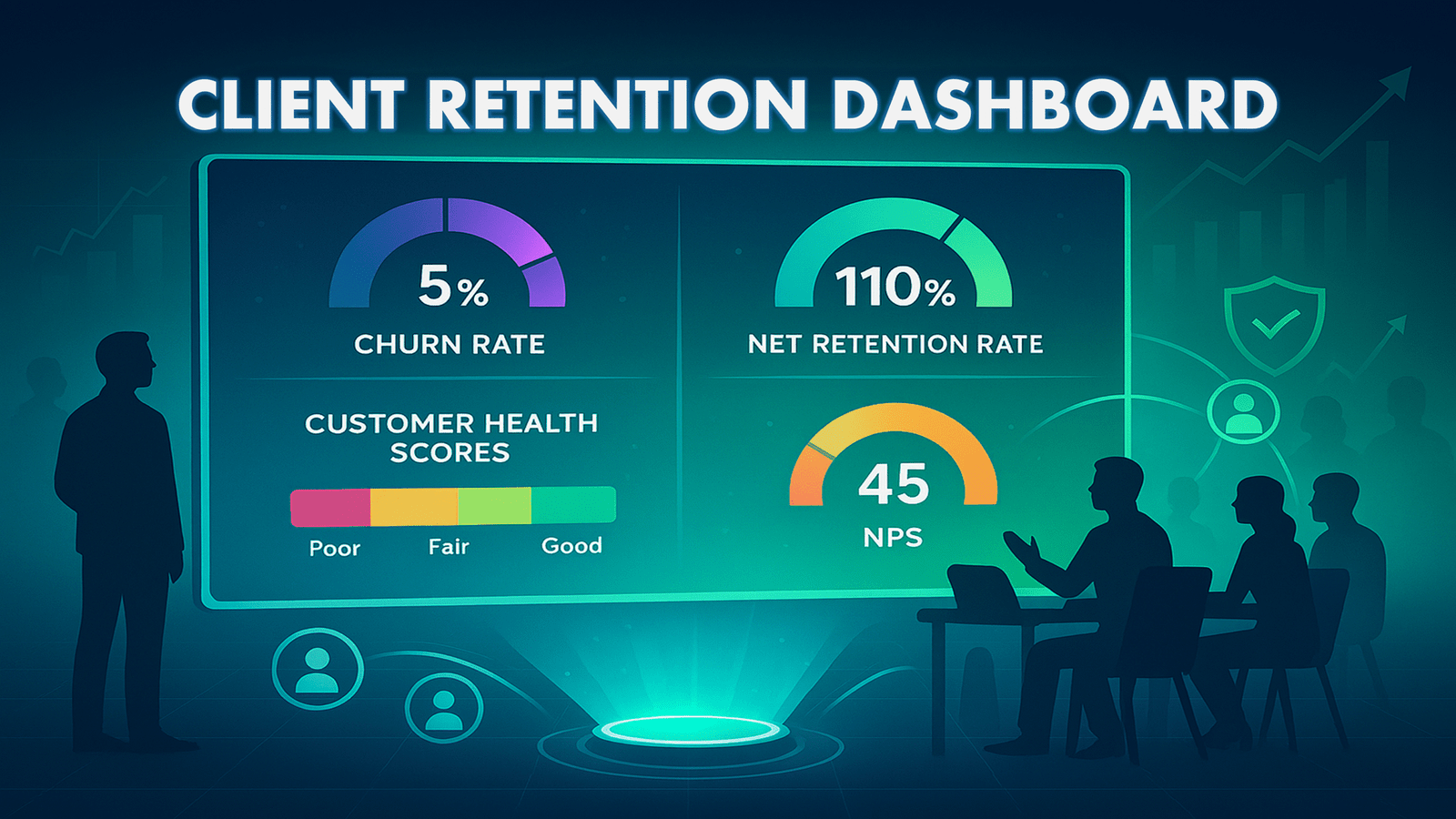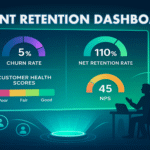Now Reading: Boost Client Retention with This Dashboard Strategy
-
01
Boost Client Retention with This Dashboard Strategy

Boost Client Retention with This Dashboard Strategy
The cost of winning a new customer is five to seven times higher than retaining an existing one. A solid client retention strategy is vital to sustain business growth.
Your revenue could jump between 25 to 95 percent by improving retention rates by just 5 percent. The numbers tell an interesting story – only half of top-performing companies have implemented a working retention system. Their lower-performing competitors lag behind at 18 percent.
We created this piece to help you become skilled at managing your client retention rate through a powerful dashboard approach. You’ll learn to track customer retention metrics, understand retention patterns, and apply evidence-based strategies that keep customers loyal.
Would you like to turn your customer retention analysis into a competitive edge? Let’s head over to building a retention dashboard that delivers results.
Map Your Client Journey
Your business needs to understand every interaction with clients to retain them successfully. Customer journey mapping shows these interactions visually and helps sales leaders spot key moments that shape client relationships21.
Key touchpoints
Strong retention strategies need a clear understanding of touchpoints. These interactions shape customer experience and brand perception substantially throughout their experience21. A well-laid-out journey map tracks interactions in various channels:
- Pre-purchase engagement (website visits, social media)
- Active client communications (emails, support calls)
- Post-purchase follow-ups (feedback surveys, account reviews)
- Service delivery touchpoints (onboarding, training sessions)
Research shows that companies with strong omni-channel customer engagement strategies retain 89% of their clients. Companies without these strategies keep only 33%2.
Risk assessment stages
Each touchpoint needs careful risk review to prevent losing clients. The risk assessment process aims to spot potential problems before they affect client relationships3. During 2022, 65% of organizations dealt with payment fraud attempts. One-third of U.S. consumers experienced account takeover incidents3.
A complete risk assessment framework has multiple stages. Teams must verify client identity and check account details3. They should also watch for change management events, especially when clients update their information or appear on watchlists3.
Sales teams should use proactive monitoring strategies to boost retention. This includes regular checks of client health indicators and engagement levels3. Companies need to review risks during:
- Original verification and onboarding
- Account detail modifications
- Payment processing and disbursements
- Periodic review cycles
Sales leaders can develop targeted strategies by mapping these touchpoints and their risks to boost client retention. Companies that understand and optimize these interactions build stronger, longer-lasting client relationships21.
Set Up Dashboard Metrics
Building a customer retention dashboard that works needs the right tracking tools and proper data feed setup. A well-laid-out dashboard combines key metrics from customer service, sales, and finance teams to show how well you’re keeping customers4.
Choose tracking tools
You need to evaluate how well tools integrate when picking customer retention analysis software. These tools must blend with your existing CRM systems, email marketing platforms, and customer support software5. This helps keep data consistent and gives you a complete picture of your customer’s experience.
Primary metrics to track include:
- Net retention rate and monthly recurring revenue (MRR)
- Customer health scores and satisfaction levels
- Account retention and expansion rates
- Churn and cancelation patterns1
The tools you pick should have easy-to-use dashboards with flexible reporting options. These features help teams watch important metrics and make evidence-based decisions5. Research shows that companies using strong tracking systems get better at keeping their customers6.
Configure data feeds
A good retention dashboard needs properly configured data feeds. This means using consistent naming across data sources and making sure data formats match7. You’ll need to validate data and keep it current.
To set up reliable data feeds:
- Define clear field mappings and data formats
- Configure transport mechanisms for data retrieval
- Establish validation protocols
- Set up automated scheduling for regular updates8
The dashboard should track essential customer success metrics like retention, churn, cancelations, contractions, and expansions1. This complete approach helps teams spot problems before they become serious issues.
Proper data feed management lets you track how different customer groups perform and calculate customer lifetime value9. Teams can fine-tune their customer success approach by watching resolution outcomes and ticket volumes.
Your dashboard’s success depends on how well it handles data from multiple sources, including CRM systems, billing platforms, and customer interaction tools7. This combination provides vital insights into account status, revenue activity, and customer health metrics that shape retention strategies.
Empower Your Sales Team
Your sales team needs the right tools and knowledge to build a strong customer retention strategy. Teams that use evidence-based insights show a 28% higher performance rate in client relationships10.
Dashboard training
A complete training program helps your team master dashboard functions. Companies that implement full dashboard training programs help new sales representatives become productive 45% faster11. The training must cover data interpretation, visualization tools and how to use insights.
Access levels
The right access levels protect data security and keep operations running smoothly. You should set up role-based permissions that line up with team duties. Sales managers need to see all team performance metrics. Individual representatives should focus on their specific accounts and performance data10.
Response guidelines
Clear response protocols make dashboards more effective when combined with proper access management. Your team should follow these guidelines:
- Monitor real-time alerts for client engagement changes
- Address high-risk accounts within 24 hours
- Track response times for client communications
- Document intervention outcomes and success rates
Performance tracking
Dashboard-based performance tracking lets sales leaders spot improvement areas and success patterns. Teams that use performance dashboards show a 23% increase in meeting sales targets12.
Your system should track these key metrics:
- Individual and team quota attainment
- Average deal cycle length
- Client health scores
- Response time efficiency
AI-powered automation lets sales teams focus on high-value activities while handling routine tasks automatically12. This method has reduced manual administrative work by up to 40%12.
Regular performance reviews using dashboard insights reveal coaching opportunities and areas needing extra support. Sales leaders should hold team-wide discussions and individual check-ins to tackle specific challenges and share winning strategies12.
Implement Retention Strategies
Measuring and tracking customer satisfaction are the life-blood of retention strategies that work. Companies can improve their customer retention rates through systematic monitoring and active customer involvement.
Client health scoring
Client health scoring helps predict and prevent customer churn through analytical insights. A complete health score combines qualitative and quantitative measures to assess customer relationships13. These scores typically range from 1 to 100 or use color-coding from red to green. They give quick visual feedback about account status14.
Effective health scoring includes multiple dimensions beyond product adoption:
- Sentiment and involvement levels
- Value realization metrics
- Platform usage patterns
- Response rates to communications
- Payment history and account status
Companies that implement accurate health scores see remarkable improvements. Those using health score thresholds for targeted interventions have increased renewals by 20%13.
Engagement programs
Strong engagement programs play a vital role in maintaining customer relationships. MobileCo identified 18 distinct improvement categories across marketing, service, and user involvement after implementing complete engagement initiatives15.
Successful engagement programs work like a well-oiled machine with multiple components:
- Educational Resources: Step-by-step instructions, live demos, and complete online resources help customers maximize product value16.
- Community Building: Online forums and user groups encourage customer loyalty. Customers exchange ideas and offer peer support here17.
- Loyalty Rewards: Tiered programs based on usage or spending give points for specific actions and referral bonuses17.
Quick identification of engagement opportunities matters greatly. Organizations should collect feedback through multiple channels regularly. Digital surveys, monthly check-ins, and customer advisory boards help achieve this goal16. This approach allows quick response to changing customer needs and shows commitment to customer success.
Companies that prioritize customer feedback and take prompt action show better retention rates18. Consistent monitoring and involvement help address potential issues early. This deepens customer commitment and encourages long-term loyalty.
Measure Dashboard ROI
“It costs five times as much to attract a new customer, as it does to keep an existing one.” — Frederick Reichheld, Business strategist and author, creator of the Net Promoter Score
Customer retention dashboards provide clear returns for businesses in several ways. Research from Harvard Business Review shows that finding new customers costs five to 25 times more than keeping existing ones19.
Cost savings analysis
Businesses save money when they track retention metrics through dashboards. These tools help companies spot potential issues early by monitoring customer behavior and engagement. This proactive approach prevents customers from leaving1.
A complete retention dashboard helps organizations:
- Track net retention rates and monthly recurring revenue
- Keep an eye on account health and satisfaction levels
- Study why customers leave and how to prevent it
- Measure customer lifetime value metrics
- Figure out savings from reduced acquisition needs
Companies that use retention dashboards spend less money on finding new customers19. The dashboard helps predict when customers might leave and stops it from happening. This saves money because keeping existing customers costs less than finding new ones.
Retention improvements
Dashboard-driven retention strategies have a big effect on revenue growth. The numbers tell an interesting story – just a 5% boost in customer retention can increase revenue by 25% to 95%19. These results show why focusing on retention matters.
The most successful businesses aim for net retention rates of 100% or higher. This suggests steady monthly growth and happy customers1. Companies learn more about customer behavior patterns and lifetime value by watching retention groups closely20.
We noticed that businesses using dashboards to track retention do better in:
- Getting customers to buy again
- Customer lifetime value
- Keeping revenue stable
- Finding ways to grow accounts
Team efficiency gains
Retention dashboards change how teams work and boost their productivity. Companies using these dashboard strategies spend 40% less time on administrative tasks4. Teams can focus on building better customer relationships instead of paperwork.
The dashboard makes work easier by sending tickets to the right departments quickly19. Customers love this approach – 73% say quick problem-solving is vital for a good experience19.
Teams work better with dashboards because they:
- Make customer service simpler
- Speed up response times
- Route tickets better
- Track performance easily
- Create reports faster
Teams work together better when retention metrics are in one place4. This team approach, backed by dashboard data, helps companies use their resources wisely and make smart decisions across departments.
Conclusion
Customer retention dashboards are vital tools that drive modern business growth and sustainability. Companies using these systems report notable improvements in retention rates, cost savings, and team efficiency.
Organizations can reshape their retention efforts through customer experience mapping, metric tracking, and team strengthening strategies. Sales teams with dashboard insights make better decisions and respond faster to client needs. These teams build stronger customer relationships.
Consistent monitoring, analysis, and action based on dashboard data lead to success. Companies that become skilled at these elements see substantial returns. Some achieve up to 95% revenue growth from just a 5% increase in retention rates.
Successful retention management needs dedication to both data analysis and customer relationships. Your customer loyalty will grow steadily when you start with clear metrics and give your team the right tools.
FAQs
Q1. How can a customer retention dashboard improve my business? A customer retention dashboard can significantly boost your business by helping you track key metrics, identify at-risk clients, and implement targeted retention strategies. It can lead to cost savings, increased revenue, and improved team efficiency.
Q2. What are the essential metrics to include in a retention dashboard? Essential metrics for a retention dashboard include net retention rate, monthly recurring revenue, customer health scores, account retention rates, and churn patterns. These metrics provide a comprehensive view of your customer relationships and retention performance.
Q3. How do I train my sales team to effectively use a retention dashboard? Train your sales team by providing comprehensive instruction on dashboard functionalities, data interpretation, and practical application of insights. Establish clear response guidelines and implement regular performance reviews using dashboard data to identify coaching opportunities.
Q4. What is client health scoring and why is it important? Client health scoring is a data-driven approach to evaluate customer relationships using both qualitative and quantitative measures. It’s important because it helps predict and prevent customer churn, allowing businesses to take proactive measures to retain clients.
Q5. How can I measure the ROI of implementing a retention dashboard? Measure the ROI of your retention dashboard by analyzing cost savings from reduced customer acquisition needs, tracking improvements in retention rates and their impact on revenue, and monitoring gains in team efficiency. Look for reductions in manual tasks and improvements in response times and customer satisfaction.
References
[1] – https://www.klipfolio.com/resources/dashboard-examples/saas/customer-retention-dashboard
[2] – https://www.ciotechoutlook.com/editors-column/how-to-use-customer-journey-mapping-to-improve-customer-retention-nid-11981-cid-73.html
[3] – https://www.lseg.com/en/risk-intelligence/account-verification-solutions/customer-life-cycle-risk-management
[4] – https://www.plecto.com/dashboard-examples/customer-service/customer-retention-dashboards/
[5] – https://rewardtheworld.net/how-to-choose-customer-retention-analysis-tools/
[6] – https://www.appcues.com/blog/customer-retention-metrics
[7] – https://www.phoenixstrategy.group/blog/how-to-build-a-saas-retention-dashboard
[8] – https://help.archerirm.cloud/platform_2024_11/en-us/content/platform/integration/int_dfm_basics.htm
[9] – https://www.toucantoco.com/en/blog/metrics-saas-customer-retention-dashboard-examples
[10] – https://learn.microsoft.com/en-us/partner-center/insights/customer-retention-dashboard
[11] – https://www.salesforce.com/in/sales/performance-management/sales-kpis/
[12] – https://www.pipedrive.com/en/blog/measure-track-entire-sales-teams-performance
[13] – https://www.gainsight.com/blog/modernize-health-scores-in-order-to-monetize-retention-and-expansion/
[14] – https://www.custify.com/blog/customer-health-score-guide/
[15] – https://www.bain.com/client-results/focus-on-customer-engagement-to-improve-retention/
[16] – https://www.outreach.io/resources/blog/customer-retention-strategies
[17] – https://userpilot.com/blog/how-to-improve-customer-retention/
[18] – https://www.salesforce.com/ap/hub/service/customer-retention-strategies/
[19] – https://www.zendesk.com/in/blog/customer-retention/
[20] – https://documentation.bloomreach.com/engagement/docs/retention-dashboard
[21] – https://blog.hubspot.com/service/customer-touchpoints
















Anonymous
çok başarılı ve kaliteli bir makale olmuş güzellik sırlarım olarak teşekkür ederiz.
“It’s a very successful and high-quality article — thank you on behalf of My Beauty Secrets.”
Shashi M.
Thank you for the generous feedback — it’s great to hear the piece delivered value for My Beauty Secrets. Your acknowledgement is truly appreciated.
If there’s any additional angle you’d like to explore or deeper insights you want to unlock, I’m here to support your content journey and help you continue elevating your brand narrative.
القرفة للتنحيف
Hmm it looks like your blog ate my first comment (it was extremely long) so I guess I’ll
just sum it up what I wrote and say, I’m thoroughly enjoying your blog.
I as well am an aspiring blog blogger but I’m still new
to everything. Do you have any tips for newbie blog writers? I’d genuinely appreciate it.
Shashi M.
Thank you for the thoughtful message — and apologies on behalf of the blog gremlins for eating your first comment. Happens to the best of us.
I’m glad you’re enjoying the content, and it’s great to hear you’re stepping into the blogging arena. Since you’re building your foundation, here are a few high-impact, beginner-friendly tips that consistently move the needle:
1. Focus on clarity over perfection
Early on, momentum beats mastery. Ship content, learn, iterate. Perfection is a bottleneck; consistency is a growth engine.
2. Build a signature voice
Readers come for information but stay for personality. Define the tone you want — helpful, witty, analytical, bold — and lean into it intentionally.
3. Start with topics you know cold
Your confidence will show in the writing. As you get traction, you can expand into more complex or adjacent themes.
4. Prioritize structure
A clean flow (hook → core insight → examples → takeaway) keeps readers engaged and reduces bounce.
5. Optimize for readability
Short paragraphs, punchy sentences, and scannable formatting elevate the user experience and keep attention high.
6. Engage with your audience
Reply to comments, ask questions, invite feedback. Community fuels content — and content fuels growth.
7. Learn basic SEO early
You don’t need to be an expert. Just understand search intent, keyword alignment, headers, and meta descriptions. It’s low effort, high ROI.
If you want, I can also share a starter blueprint for new bloggers — topics, posting schedule, tone guide, and growth strategy. Just say the word.
Ulises Flores
Helpful post — could you also share examples for beginners?
Shashi M.
Hi — thanks so much for reading and for the great question! Absolutely, I can share a few beginner-level examples to help you put this dashboard strategy into action right away.
Here are three expanded, easy-to-implement examples for newcomers:
1. Small Agency or Solo Service Provider
If you’re managing a handful of clients for services like web maintenance, social media, or design, your dashboard could track:
Last client interaction date — Helps you identify clients you haven’t spoken with in weeks.
Pending requests or open tasks — Ensures nothing slips through the cracks.
Contract renewal or retainer deadlines — Flags upcoming renewals so you can reach out proactively.
This simple setup helps you stay one step ahead and strengthens the client experience.
2. Freelancers Building Repeat Business
Let’s say you’re a beginner in freelance writing, coaching, or consulting. Your dashboard might include:
Project status (drafting / editing / delivered / awaiting feedback) — Keeps your workflow clear.
Client satisfaction notes — Quick summaries of past feedback, helping you personalize future interactions.
Next check-in reminders — Prompts you to follow up at natural touchpoints to secure repeat work.
This approach builds consistency and positions you as organized and client-focused.
3. Creators Offering Subscriptions or Digital Products
If you’re running a beginner-friendly subscription (like a paid newsletter, templates, or digital resources), your dashboard could track:
Subscriber growth and churn — Shows what’s working and when people tend to drop off.
Engagement metrics (opens, clicks, usage patterns) — Helps you tailor future content to what people actually want.
Renewal cycles and upcoming expirations — Allows you to send timely nudges that improve retention.
This gives you a clear pulse on your audience and helps boost long-term loyalty.
If you’d like, I can also create ready-made dashboard templates for each example so you can plug in your data and get started immediately. Just let me know!
Zion Houston
I really like reading through a post that can make men and women think. Also, thank you for allowing me to comment!
Shashi M.
Thank you for the thoughtful feedback — I appreciate it. The goal is always to spark new perspectives and create space for meaningful reflection, so I’m glad the post hit that mark for you.
And thank you for taking the time to comment. Engagement like this fuels the conversation and keeps the community moving forward. If anything else stands out or you want to dive deeper into a specific angle, I’m always here to keep the dialogue going.
Kelton Mccarty
Amazing breakdown — the numbered steps made it easy to follow.
Shashi M.
Thank you — glad to hear the structure delivered value. Clear, sequential steps are all about removing friction and driving actionable clarity, so it’s great to know the format worked for you.
If you want a deeper dive into any of the steps or a more advanced version of the workflow, just let me know. Always happy to keep the momentum going.
perde
Very well presented. Every quote was awesome and thanks for sharing the content. Keep sharing and keep motivating others.
Shashi M.
Thank you for the generous feedback — truly appreciated. I’m glad the quotes and insights resonated with you and delivered real value.
I’ll keep pushing out more content aimed at sparking motivation and keeping the energy high. If there’s a particular theme or topic you’d like to see explored next, just let me know. Always here to keep the inspiration flowing.
Best Deals Shoes
Very interesting perspective.
Shashi M.
Thank you — I appreciate that. The intent was to bring a fresh angle that sparks reflection and expands the conversation, so I’m glad the perspective landed with you.